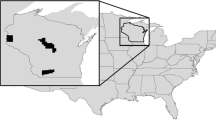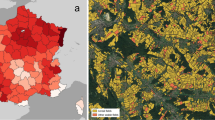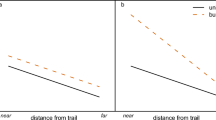Abstract
Spatio-temporal landscape heterogeneity has rarely been considered in population-level impact assessments. Here we test whether landscape heterogeneity is important by examining the case of a pesticide applied seasonally to orchards which may affect non-target vole populations, using a validated ecologically realistic and spatially explicit agent-based model. Voles thrive in unmanaged grasslands and untreated orchards but are particularly exposed to applied pesticide treatments during dispersal between optimal habitats. We therefore hypothesised that vole populations do better (1) in landscapes containing more grassland and (2) where areas of grassland are closer to orchards, but (3) do worse if larger areas of orchards are treated with pesticide. To test these hyposeses we made appropriate manipulations to a model landscape occupied by field voles. Pesticide application reduced model population sizes in all three experiments, but populations subsequently wholly or partly recovered. Population depressions were, as predicted, lower in landscapes containing more unmanaged grassland, in landscapes with reduced distance between grassland and orchards, and in landscapes with fewer treated orchards. Population recovery followed a similar pattern except for an unexpected improvement in recovery when the area of treated orchards was increased. Outside the period of pesticide application, orchards increase landscape connectivity and facilitate vole dispersal and so speed population recovery. Overall our results show that accurate prediction of population impact cannot be achieved without taking account of landscape structure. The specifics of landscape structure and habitat connectivity are likely always important in mediating the effects of stressors.





Similar content being viewed by others
References
Agrell J, Erlinge S, Nelson J, Sandell M (1996) Shifting spacing behaviour of male field voles (Microtus agrestis) over the reproductive season. Ann Zool Fenn 33(2):243–248
Andreassen HP, Ims RA (2001) Dispersal in patchy vole populations: role of patch configuration, density dependence, and demography. Ecology 82(10):2911–2926
Anway MD, Cupp AS, Uzumcu M, Skinner MK (2005) Epigenetic transgenerational actions of endocrine disruptors and mate fertility. Science 308(5727):1466–1469
Anway MD, Leathers C, Skinner MK (2006a) Endocrine disruptor vinclozolin induced epigenetic transgenerational adult-onset disease. Endocrinology 147(12):5515–5523
Anway MD, Memon MA, Uzumcu M, Skinner MK (2006b) Transgenerational effect of the endocrine disruptor vinclozolin on male spermatogenesis. J Androl 27(6):868–879
Baddeley AJ, Turner R (2005) Spatstat: an R package for analysing spatial point patterns. J Stat Softw 12(6):1–42
Baddeley AJ, Moller J, Waagepetersen R (2000) Non- and semi-parametric estimation of interaction in inhomogeneous point patterns. Stat Neerlandica 54(3):329–350
Barrett LW, Bohlen PJ (1991) Landscape ecology. In: Hudson WE (ed) Landscape linkages and biodiversity. Island, Washington, DC, pp 149–191
Bates DM, Chambers JM (1992) Nonlinear models. In: Chambers JM, Hastie TJ (eds) Statistical models in S: Wadsworth and Brooks/Cole Computer science series. Wadsworth and Brooks/Cole, Pacific Grove, pp 377–421
Bates DM, Watts DG (1988) Nonlinear regression analysis and its applications. Wiley, New York
Benschop J, Stevenson MA, Dahl J, Morris RS, French NP (2009) Informing surveillance programmes by investigating spatial dependency of subclinical Salmonella infection. Epidemiol Infect 137(9):1348–1359
Brown JH, Kodricbrown A (1977) Turnover rates in insular biogeography—effect of immigration on extinction. Ecology 58(2):445–449
Cairns J (1993) Will there ever be a field of landscape toxicology. Environ Toxicol Chem 12(4):609–610
Cairns J, Niederlehner BR (1996) Developing a field of landscape ecotoxicology. Ecol Appl 6(3):790–796
Crocker DR, Hart ADM, Gurney J, McCoy C (2002) Estimation daily food intake of wild birds and mammals. www.ec.europa.eu/food/plant/protection/evaluation/guidance/wrkdoc19_en.pdf, Appendix I, accessed on 19 Aug 2013
Dalkvist T, Topping CJ, Forbes VE (2009) Population-level impacts of pesticide-induced chronic effects on individuals depend more on ecology than toxicology. Ecotoxicol Environ Saf 72(6):1663–1672
Elkin CM, Possingham H (2008) The role of landscape-dependent disturbance and dispersal in metapopulation persistence. Am Nat 172(4):563–575
Erlinge S, Hoogenboom I, Agrell J, Nelson J, Sandell M (1990) Density-related home-range size and overlap in adult field voles (Microtus agrestis) in Southern Sweden. J Mamm 71(4):597–603
Ersboll AK, Ersboll BK (2007) Simulation of the K-function in the analysis of spatial clustering for non-randomly distributed locations-exemplified by bovine virus diarrhoea virus (BVDV) infection in Denmark. In GisVet 2007 Conference, Copenhagen, pp 64–71
Fahrig L, Freemark K (1995) Landscape-scale effects of toxic events for ecological risk assessment. In: Cairns JJ, Niederlehner BR (eds) Ecological toxicity testing: scale, complexity, relevance. Lewis, Boca Raton, pp 193–208
Fahrig L, Nuttle WK (2005) Population ecology in spatially heterogeneous environments. In: Lovett GM, Jones CG, Turner MG, Weathers KC (eds) Ecosystem function in heterogeneous landscapes. Springer, New York, pp 95–118
FOCUS (2001) FOCUS surface water scenarios in the EU evaluation process under 91/414/EEC. Report of the FOCUS working group on surface water scenarios. Report of the FOCUS working group on surface water scenarios, EC Document Reference SANCO/4802/2001-rev-2
Frank K, Wissel C (1998) Spatial aspects of metapopulation survival—from model results to rules of thumb for landscape management. Landscape Ecol 13(6):363–379
Gaines KF, Boring CS, Porter DE (2005) The development of a spatially explicit model to estimate radiocaesium body burdens in raccoons (Procyon lotor) for ecological risk assessment. Sci Total Environ 341(1–3):15–31
Godfrey GK (1953) The food of Microtus agrestis hirtus (Bellamy,1839) in Wytham, Berkshire. Säugetierk Mitt 1:148–151
Gray LE, Ostby J, Monosson E, Kelce WR (1999) Environmental antiandrogens: low doses of the fungicide vinclozolin alter sexual differentiation of the male rat. Toxicol Ind Health 15(1–2):48–64
Grimm V, Railsback SF (2005) Individual-based modeling and ecology. Princeton University Press, Princeton
Grimm V, Revilla E, Berger U, Jeltsch F, Mooij WM, Railsback SF, Thulke HH, Weiner J, Wiegand T, DeAngelis DL (2005) Pattern-oriented modeling of agent-based complex systems: lessons from ecology. Science 310(5750):987–991
Haddad NM (1999) Corridor and distance effects on interpatch movements: a landscape experiment with butterflies. Ecol Appl 9(2):612–622
Haddad NM, Bowne DR, Cunningham A, Danielson BJ, Levey DJ, Sargent S, Spira T (2003) Corridor use by diverse taxa. Ecology 84(3):609–615
Hanski I (1994) A practical model of metapopulation dynamics. J Anim Ecol 63(1):151–162
Hanski I (1999) Metapopulation ecology. Oxford University Press, Oxford
Hansson L (1971) Habitat, food and population dynamics of the field vole Microtus agrestis (L.) in South Sweden. Viltrevy 8:267–378
Hansson L (1977) Spatial dynamics of field voles Microtus agrestis in heterogeneous landscapes. Oikos 29(3):539–544
Holt RD (1984) Spatial heterogeneity, indirect interactions, and the coexistence of prey species. Am Nat 124(3):377–406
Illian JB, Moller J, Waagepetersen RP (2009) Hierarchical spatial point process analysis for a plant community with high biodiversity. Environ Ecol Stat 16(3):389–405
Jensen TS, Hansen TS (2001) Effekten af husdyrgræsning på småpattedyr. In: Pedersen LB, Buttenschøn RM, Jensen TS (eds) Græsning på ekstensivt drevne naturarealer—effekter på stofkredsløb og naturindhold—Park-og landskabsserien 34. Skov og Landskab, Hørsholm, pp 107–121
Kapustka LA (2003) Rationale for use of wildlife habitat characterization to improve relevance of ecological risk assessments. Hum Ecol Risk Assess 9(6):1425–1430
Kindlmann P, Burel F (2008) Connectivity measures: a review. Landscape Ecol 23(8):879–890
Kooistra L, Huijbregts MAJ, Ragas AMJ, Wehrens R, Leuven R (2005) Spatial variability and uncertainty in ecological risk assessment: a case study on the potential risk of cadmium for the little owl in a Dutch river flood plain. Environ Sci Technol 39(7):2177–2187
Laan R, Verboom B (1990) Effects of pool size and isolation on amphibian communities. Biol Conserv 54(3):251–262
LeMay V, Pommerening A, Marshall P (2009) Spatio-temporal structure of multi-storied, multi-aged interior Douglas fir (Pseudotsuga menziesii var. glauca) stands. J Ecol 97(5):1062–1074
Levey DJ, Bolker BM, Tewksbury JJ, Sargent S, Haddad NM (2005) Effects of landscape corridors on seed dispersal by birds. Science 309:146–148
Myllymaki A (1977) Demographic mechanisms in fluctuating populations of field vole Microtus agrestis. Oikos 29(3):468–493
Nabe-Nielsen J, Sibly RM, Forchhammer MC, Forbes VE, Topping CJ (2010) The effects of landscape modifications on the long-term persistence of animal populations. PLoS One 5(1):e8932
Pe’er G, Heinz SK, Frank K (2006) Connectivity in heterogeneous landscapes: analyzing the effect of topography. Landscape Ecol 21(1):47–61
Pita R, Beja P, Mira A (2007) Spatial population structure of the Cabrera vole in Mediterranean farmland: the relative role of patch and matrix effects. Biol Conserv 134(3):383–392
Pulliam HR (1988) Sources, sinks, and population regulation. Am Nat 132(5):652–661
Revilla E, Wiegand T (2008) Individual movement behavior, matrix heterogeneity, and the dynamics of spatially structured populations. Proc Natl Acad Sci USA 105(49):19120–19125
Royer F, Fromentin JM, Gaspar P (2004) Association between bluefin tuna schools and oceanic features in the western Mediterranean. Mar Ecol Progr Ser 269:249–263
Saunders DA, Hobbs RJ, Arnold GW (1993) The kellerberrin project on fragmented landscapes—a review of current information. Biol Conserv 64(3):185–192
Sibly RM, Akcakaya HR, Topping CJ, O’Connor RJ (2005) Population-level assessment of risks of pesticides to birds and mammals in the UK. Ecotoxicology 14(8):863–876
Stenseth NC (1985) Why mathematical models in evolutionary ecology? In: Cooley JH, Golley FB (eds) Trends in ecological research for the 1980s. Plenum, New York, pp 239–287
Thomas CD (2000) Dispersal and extinction in fragmented landscapes. Proc R Soc Lond Ser B 267(1439):139–145
Thomas CD, Hanski I (1997) Butterfly metapopulations. In: Hanski I, Gilpin ME (eds) Metapopulation biology. Academic Press, San Diego, pp 359–386
Tischendorf L, Fahrig L (2000) How should we measure landscape connectivity? Landscape Ecol 15(7):633–641
Topping C, Østergaard S, Pertoldi C, Bach LA (2003a) Modelling the loss of genetic diversity in vole populations in a spatially and temporally varying environment. Ann Zool Fenn 40(3):255–267
Topping CJ, Hansen TS, Jensen TS, Jepsen JU, Nikolajsen F, Odderskaer P (2003b) ALMaSS, an agent-based model for animals in temperate European landscapes. Ecol Model 167(1–2):65–82
Topping CJ, Sibly RM, Akcakaya HR, Smith GC, Crocker DR (2005) Risk assessment of UK skylark populations using life-history and individual-based landscape models. Ecotoxicology 14(8):925–936
Topping CJ, Dalkvist T, Forbes VE, Grimm V, Sibly RM (2009) The potential for the use of agent-based models in ecotoxicology. In: Devillers J (ed) Ecotoxicology modeling, emerging topics in ecotoxicology. Springer, New York, pp 205–235
Topping CJ, Høye TT, Odderskaer P, Aebischer NJ (2010a) A pattern-oriented modelling approach to simulating populations of grey partridge. Ecol Model 221(5):729–737
Topping CJ, Høye TT, Olesen CR (2010b) Opening the black box-development, testing and documentation of a mechanistically rich agent-based model. Ecol Model 221(2):245–255
Topping CJ, Dalkvist T, Grimm V (2012) Post-hoc pattern-oriented testing and tuning of an existing large model: lessons from the field vole. PLoS One 7(9):e45872
Topping CJ, Odderskaer P, Kahlert J (2013) Modelling skylarks (Alauda arvensis) to predict impacts of changes in land management and policy: development and testing of an agent-based model. PLoS One 8(6):e65803
Turner MG, Ruscher CL (1988) Changes in landscape patterns in Georgia, USA. Landscape Ecol 1:241–251
Vos CC, Stumpel HP (1995) Comparison of habitat-isolation parameters in relation to fragmented distribution patterns in the tree frog (Hyla arborea). Landscape Ecol 11:203–214
Vuilleumier S, Wilcox C, Cairns BJ, Possingham HP (2007) How patch configuration affects the impact of disturbances on metapopulation persistence. Theor Popul Biol 72(1):77–85
Wiens JA, Stenseth NC, Vanhorne B, Ims RA (1993) Ecological mechanisms and landscape ecology. Oikos 66(3):369–380
Acknowledgments
This research has been sponsored by the Danish Natural Science Research Council and the Centre for Integrated Population Ecology (CIPE).
Author information
Authors and Affiliations
Corresponding author
Electronic supplementary material
Below is the link to the electronic supplementary material.
Rights and permissions
About this article
Cite this article
Dalkvist, T., Sibly, R.M. & Topping, C.J. Landscape structure mediates the effects of a stressor on field vole populations. Landscape Ecol 28, 1961–1974 (2013). https://doi.org/10.1007/s10980-013-9932-7
Received:
Accepted:
Published:
Issue Date:
DOI: https://doi.org/10.1007/s10980-013-9932-7




